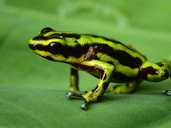|
Andinobates fulguritus (Silverstone, 1975)
Yellow-bellied Poison Frog | family: Dendrobatidae subfamily: Dendrobatinae genus: Andinobates |
 © 2020 Amadeus Plewnia (1 of 9) |
|
|
|
Description Description: The snout-vent length for adults is 13.5 mm to 16.5 mm (Silverstone 1975; Jungfer et al. 1996). The dorsum is slightly granulated and the venter is moderately granulated, except for the palms and soles. A. fulguritus lacks teeth. It has a subtruncate snout tip from the dorsal aspect. This snout tip is rounded in lateral aspect. It has a rounded canthus rostralis. The loreal region is vertical. The tympanum is round; its diameter is smaller than the eye by half the eye’s diameter. An omosternum is present. There is no webbing or fringes on the toes. It lacks a tarsal tubercle (Silverstone 1975). Coloration: The ground color of the dorsum is gold, yellow, or yellow-green. It has complete dorsolateral and incomplete black lateral stripes. Its flanks are black. Ventral surfaces are yellow. The abdomen is gold or yellow with black marbling or spots. There are two black spots on either side of the throat and a median black throat spot that, in some frogs, join together. The anterior of the dorsum has an incomplete median stripe. The iris is black (Silverstone 1975). Coloration in Preservation: In preservative, gold, yellow, and yellow-green coloration fade to gray and the abdomen is predominantly light (Silverstone 1975). Tadpole morphology: Tadpoles have a laterally indented oral disk (Silverstone 1975). Variation: Individuals vary slightly in their incomplete median stripes and dorsolateral stripe pattern. The throat patterns may also slightly vary as well as the ventral patterns, which may be marbled or spotted (Silverstone 1975). Distribution and Habitat Country distribution from AmphibiaWeb's database: Colombia, Panama
Tadpoles were found in the leaf axils of bromeliads (Silverstone 1975). Life History, Abundance, Activity, and Special Behaviors Eggs are carried from the deposition site on the forest floor to bromeliads for development (Solís et al. 2004). Calls consist of irregularly repeated soft buzzing notes of a mean duration of 0.529 s and 146.8 pulses per second. Males start calling at the age of 6 months (Jungfer et al. 1996). During mating, a male guides a female to a site, deposits sperm, and leaves. Then the female lays 1 to 5 eggs. No amplexus occurs between the male and female. Parental care is continued by the male who visits the clutch irregularly and transports the larvae singly or in small groups to different water bodies. After that, larvae are left on their own. Females start depositing clutches after 9 months (Jungfer et al. 1996). Trends and Threats Populations do exist within protected areas such as Parque Nacional Chagres (Chagres National Park) and Area de Manejo Especial Nusagandi in Panama, and in several other protected areas in Colombia (Solís et al. 2004). Possible reasons for amphibian decline General habitat alteration and loss Comments The name fulguritus comes from the Latin word for “struck by lightning” (Silverstone 1975). In captivity, A. fulguritus does well at temperatures of 20 to 27 ºC. Captive individuals can be fed Drosophila melanogaster and collembolas (Jungfer et al. 1996).
References
Frank Solís, Roberto Ibáñez, César Jaramillo, Querube Fuenmayor, Karl-Heinz Jungfer, Wilmar Bolívar (2004). Ranitomeya fulgurita. In: IUCN 2011. 2011 IUCN Red List of Threatened Species. www.iucnredlist.org. Downloaded on 03 April 2012. Grant, T., Frost, D. R., Caldwell, J. P., Gagliardo, R., Haddad, C. F. B., Kok, P. J. R., Means, D. B., Noonan, B. P., Schargel, W. E., and Wheeler, W. C. (2006). ''Phylogenetic systematics of dart-poison frogs and their relatives (Amphibia: Athesphatanura: Dendrobatidae).'' Bulletin of the American Museum of Natural History, (299), 1-262. Jungfer, K.-H. Birkhahn, H., Külpmann, V., and Wassmann, K. (1996). ''Haltung und Fortpflanzung von Dendrobates fulguritus Silverstone, 1975, mit Anmerkungen zur Gattung Minyobates Myers, 1987.'' Herpetofauna, 194, 19-27. Myers, C. (1987). ''New generic names for some neotropical poison frogs (Dendrobatidae).'' Papéis Avulsos de Zoologia, 36(25), 301-306. Silverstone, P. A. (1975). ''A revision of the poison-arrow frogs of the genus Dendrobates Wagler.'' Natural History Museum of Los Angeles County, Scientific Bulletin, 21, 1-55. Originally submitted by: Kristen Slattery, Caitlin Garner, and Alexa Mutti (first posted 2010-09-28) Edited by: Mingna (Vicky) Zhuang (2012-04-29) Species Account Citation: AmphibiaWeb 2012 Andinobates fulguritus: Yellow-bellied Poison Frog <https://amphibiaweb.org/species/1690> University of California, Berkeley, CA, USA. Accessed Nov 29, 2024.
Feedback or comments about this page.
Citation: AmphibiaWeb. 2024. <https://amphibiaweb.org> University of California, Berkeley, CA, USA. Accessed 29 Nov 2024. AmphibiaWeb's policy on data use. |


 Map of Life
Map of Life